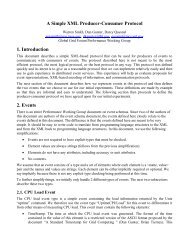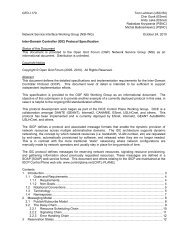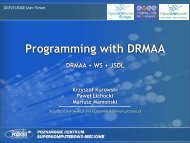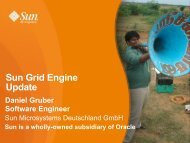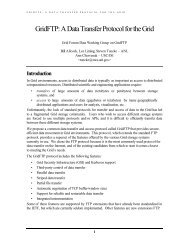Grid computing for energy exploration - Open Grid Forum
Grid computing for energy exploration - Open Grid Forum
Grid computing for energy exploration - Open Grid Forum
You also want an ePaper? Increase the reach of your titles
YUMPU automatically turns print PDFs into web optimized ePapers that Google loves.
<strong>Grid</strong> <strong>computing</strong> <strong>for</strong> <strong>energy</strong> <strong>exploration</strong><br />
Dimitri Bevc 1 , Sergio E. Zarantonello 2 , Neena Kaushik 3 , Iulian Musat 4<br />
Abstract<br />
3-D seismic imaging is the most computationally intensive task in the oil and gas industry. It is a key<br />
technology that has allowed the success ratio of exploratory wells to increase from 20% to 80%. The<br />
objective of this paper is to give an overview of a <strong>Grid</strong>-enabled environment <strong>for</strong> seismic imaging developed<br />
by 3DGeo and comment on its use in a production setting. This system addresses the demand <strong>for</strong> advanced<br />
seismic imaging applications in the oil and gas industry, and the ensuing need of computational and data<br />
resources to run these applications flexibly and efficiently.<br />
1. Introduction<br />
A key task in <strong>exploration</strong> geophysics is the creation of images of the subsurface of the<br />
earth to identify deposits of oil and gas. The earth's response to trains of artificially<br />
created elastic waves is recorded with arrays of geophones. This data is then processed to<br />
ultimately deliver images of the subsurface. The construction of accurate 3-D images of<br />
the subsurface from this data is an extremely resource-intensive task. It requires the<br />
handling of large data volumes - on the order of 10-15 Terabytes <strong>for</strong> a single modern<br />
marine 3-D survey - and the application of computationally-demanding imaging<br />
algorithms. Only large-scale parallel computers can apply these algorithms and deliver<br />
the results within a useful turn-around time. Furthermore, the most advanced imaging<br />
technologies are resource-demanding and only feasible today on small-sized projects.<br />
Harnessing <strong>Grid</strong> resources flexibly and effectively is thus a fundamentally important<br />
development <strong>for</strong> the oil and gas industry.<br />
In this paper we describe our work developing a <strong>Grid</strong>-enabled system <strong>for</strong> seismic<br />
imaging.<br />
3DGeo is a leading-edge provider of advanced software products and services to the oil<br />
and gas industry 5 . Its commercial offerings include INSP (Bevc and Popovici, 2003), a<br />
proprietary Java based Internet infrastructure <strong>for</strong> remote collaborative seismic processing<br />
1 3DGeo Development Inc., 4633 Old Ironsides Drive, Santa Clara, CA 95054 (dimitri@3dgeo.com).<br />
2 3DGeo Development, Inc., 4633 Old Ironsides Drive, Santa Clara, CA 95054 (sergio@3dgeo.com), and<br />
Department of Applied Mathematics, Santa Clara University, 500 El Camino Real, Santa Clara, CA 95053<br />
(szarantonello@scu.edu).<br />
3 3DGeo Development, Inc., 4633 Old Ironsides Drive, Santa Clara, CA 95054 (neena@3dgeo.com), and<br />
Department of Computer Engineering Santa Clara University, 500 El Camino Real, Santa Clara, CA<br />
95053 (nrkaushik@scu.edu).<br />
4 3DGeo Development Inc., 17171 Park Row, Houston, TX 77084 (iulian@3dgeo.com).<br />
5 3DGeo Development, Inc., http://www.3dgeo.com/
and seismic imaging, and a suite of advanced imaging applications that can be accessed,<br />
executed, and monitored with the INSP system. The conversion of INSP to a <strong>Grid</strong>enabled<br />
system, providing flexible and secure access to advanced imaging applications<br />
and to the resources to run these applications whenever and wherever needed, is a<br />
strategic step <strong>for</strong> 3DGeo. We believe such a system will allow 3-D seismic data to be<br />
much more effectively used to characterize and delineate oil reservoirs and contribute to<br />
opening up <strong>exploration</strong> venues in extremely complicated geological conditions. A major<br />
oil discovery in these areas could decrease United State's dependence on imported oil and<br />
have a direct impact on the cost of <strong>energy</strong>.<br />
The organization of the paper is as follows. In Section 2 we give an overview of 3-D<br />
depth imaging, we discuss the computational cost of different algorithms, and give an<br />
overview of Kirchhoff depth migration, a typical 3-D imaging application. In Section 3<br />
we discuss design issues associated to PSDM, a particular implementation of Kirchhoff<br />
migration, in a <strong>Grid</strong> environment. In Section 4 we give an overview of the INSP seismic<br />
processing system and the specifics of the <strong>Grid</strong>-enabled extension. In Section 5 we<br />
discuss the implications of seismic imaging on the <strong>Grid</strong> and give our conclusions.<br />
2. Seismic imaging<br />
Seismic imaging methods solve an inverse problem <strong>for</strong> the classical wave equation of<br />
mathematical physics, whereby signals recorded by geophones on the surface of the Earth<br />
are converted to a model of the subsurface. 3-D depth imaging methods are the most<br />
computationally-intensive tasks in the oil and gas industry. These methods are usually<br />
classified into two categories: methods based on the Kirchhoff integral equation, and<br />
methods that operate directly with the wave equation. Wave-equation methods are further<br />
classified as shot-receiver (e.g. common azimuth and narrow azimuth methods) and shotprofile<br />
methods. Wave equation shot profile methods are the most computationally<br />
expensive methods in use, and are unfeasible except <strong>for</strong> small projects.<br />
Table 1. The computational challenge: Gulf of Mexico 3-D marine surveys.<br />
Size of data<br />
Runtime in days<br />
Blocks Gbytes Kirchhoff Narrow azimuth Shot profile<br />
10 620 3 31 184<br />
100 6,200 111 1,100 6,640<br />
500 30,700 996 9,960 59,800 (164 yrs !)<br />
To put the computational challenge in perspective, in Table 1 we compare the estimated<br />
runtimes of hypothetical imaging projects <strong>for</strong> Deep Gulf of Mexico 3-D marine surveys<br />
on a 128-CPU cluster of 2.4 GHz Pentium® 4 processors delivering a sustained<br />
per<strong>for</strong>mance of 900 Mflops/CPU. Running shot profile migration on a large 3-D marine
survey would take 164 years to complete on such system ! The INSP system has modules<br />
<strong>for</strong> all the methods represented in Table 1.<br />
The better accuracy offered by advanced methods is illustrated in Figure 1, where we<br />
compare the seismic images obtained with PSDM, 3DGeo's implementation of Kirchhoff<br />
pre-stack 3-D depth migration, and the image obtained with one of 3DGeo's waveequation<br />
migration methods (Biondi and Palacharla, 1996). The generally<br />
computationally more intensive wave-equation method gives better accuracy than<br />
Kirchhoff migration, there<strong>for</strong>e underscoring the need <strong>for</strong> more compute resources<br />
deliverable through the <strong>Grid</strong>.<br />
Figure 1. Image on left obtained using PSDM. Image on right obtained using<br />
a wave-equation migration method.<br />
3. Overview of PSDM<br />
We use PSDM as an example to illustrate design issues that were addressed <strong>for</strong> <strong>Grid</strong><br />
deployment. Pre-Stack Depth Migration (PSDM) is 3DGeo's implementation of the threedimensional<br />
Kirchhoff depth migration, one of the most comprehensive and flexible<br />
methods <strong>for</strong> imaging pre-stack 3-D seismic data. PSDM approximately solves the wave<br />
equation with a boundary integral method. The acoustic reflectivity at every point of the<br />
Earth's interior is computed by summing the recorded data on multidimensional surfaces;<br />
the shape of the summation surfaces and the summation weights are computed from the<br />
Green's functions of the single scattering wave propagation experiment.
The essence of 3-D prestack Kirchhoff migration can be expressed in the following<br />
integral equation:<br />
If the Green's functions are known this solution is exact. In a computational environment<br />
we express the integral as a sum:<br />
where A r and A s are determined by the transport equation, and t r and t s are either found<br />
by ray-tracing or by solving the eikonal equation. We note that each point x of the<br />
seismic image is calculated by a sum over a travel-time surface, and that the sums <strong>for</strong><br />
the different points of the image can be calculated independently from each other. Since<br />
the wave propagation velocity is not known a priori, the process of building an exact<br />
image is iterative, with successive improvements made to the velocity field. Each<br />
iteration requires running a Kirchhoff migration. The overall procedure, schematized in<br />
Figure 2, involves collaboration between multidisciplinary teams and can be extremely<br />
demanding in terms of human and computational resources.<br />
Figure 2. Building a 3-D seismic image requires iterative updating of the<br />
velocity model.
Parallelization of PSDM on a cluster. PSDM presents different parallelization issues in<br />
cluster and <strong>Grid</strong> environments. 3DGeo's implementation of Kirchhoff migration was<br />
designed to achieve maximum efficiency on a cluster of interconnected multiprocessor<br />
computers. To achieve this efficiency the input data is distributed among the<br />
computational nodes, while the output image is divided into processing blocks that are<br />
distributed over parallel processors on each node. At the end, the results from each node<br />
are gathered to build the final image.<br />
Figure 3 illustrates the PSDM MPI architecture. The input data is distributed using a<br />
dispatching service which responds to individual requests from each node. This approach<br />
ensures a good load balancing over heterogeneous nodes, especially if the computational<br />
demands <strong>for</strong> processing each block of input data are different. This dispatching service<br />
keeps track of the execution stage and provides necessary in<strong>for</strong>mation to restart the entire<br />
job in case of a failure, an important feature on a large distributed system where one node<br />
may become unavailable anytime during the execution.<br />
Each node has a copy of the output image which is divided into processing blocks. The<br />
summation computation <strong>for</strong> each block is distributed independently over parallel<br />
processors. By partitioning the output, the algorithm is scalable with respect to the total<br />
amount of memory available, and can run efficiently on workstations where less memory<br />
is available or on supercomputers where any remaining memory can be used <strong>for</strong> staging<br />
data. Once the entire input data is processed, the final image is composed by summing<br />
the local images from each node.<br />
Figure 3. Parallelization of PSDM on a cluster
After comparing several multi-threading libraries, we chose the <strong>Open</strong>MP 6 standard <strong>for</strong><br />
the implementation of the shared-memory parallelization on each multiprocessor node.<br />
This standard is jointly defined by a group of major computer hardware and software<br />
vendors, and provides a simple and flexible interface <strong>for</strong> developing parallel applications,<br />
portable on a variety of systems.<br />
The solution chosen to implement the input data dispatching mechanism and the<br />
collective operations used <strong>for</strong> the final summation is based on the MPI standard. We used<br />
MPICH (Groop, Doss, and Skjellum, 1996), an open source implementation of the MPI<br />
standard, optimized and tested on a variety of architectures. PSDM uses about one<br />
hundred parameters, usually extracted from a text file. Since many of those parameters<br />
refer to files on the local file system, the parameter acquisition library was augmented to<br />
accept placeholders <strong>for</strong> different MPI runtime values such as the process rank. This<br />
simplifies the laborious task of setting up a PSDM running job.<br />
PSDM on the <strong>Grid</strong>. Tests and benchmarking of PSDM on various cluster architectures<br />
and configurations shows that in a typical run the I/O operations associated with the input<br />
data distribution account <strong>for</strong> a small fraction of the total processing time. This<br />
encouraged us to use - in a first phase - the same architecture <strong>for</strong> distributing a PSDM job<br />
across multiple clusters, interconnected in a computational grid, as shown in Figure 4.<br />
Using the Globus Toolkit (Foster and Kesselman, 2003) we set up a <strong>Grid</strong>, interconnecting<br />
two of 3DGeo's processing centers (Santa Clara, Cali<strong>for</strong>nia, and Houston, Texas) and a<br />
Linux cluster at the San Diego Super<strong>computing</strong> Center.<br />
We had built PSDM using MPICH libraries, and the choice of MPICH-G2 (Karonis,<br />
Toonen, and Foster, 2003) <strong>for</strong> the necessary <strong>Grid</strong> support seemed a natural decision. The<br />
result was a <strong>Grid</strong>-enabled MPI implementation built on top of MPICH and Globus API.<br />
After re-compiling with the MPICH-G2 libraries, we were able to deploy and run a<br />
PSDM job on public IP nodes. However, since MPICH-G2 does not support private IP<br />
clusters, running a single PSDM job on two or more interconnected clusters was not<br />
possible and a modified approach was required.<br />
The main problem was due to the implementation of MPICH-G2 which required direct<br />
TCP/IP connection between the nodes of the different clusters. Since most of the clusters<br />
were configured without public IP addresses <strong>for</strong> the internal nodes, direct TCP/IP<br />
connection could not be established. For testing purposes we were able to tunnel the TCP<br />
traffic through a secure connection, setting up a VPN between two test clusters. This<br />
solution was not scalable and the settings are impractical to achieve on a commercial<br />
<strong>Grid</strong> setup where different participants have different security policies. However, the test<br />
was fruitful in assessing the limitations of the parallelization model we built <strong>for</strong> PSDM<br />
and to draw future development plans <strong>for</strong> improving it. Our present plans are to explore<br />
and use the functionality of MPICH-GP, a modification of MPICH-G2 by Kum-Rye<br />
Park. MPICH-GP includes a Network Address Translation service, and a user-level proxy<br />
scheme. MPICH-GP supports public as well as private IP clusters, and mixed<br />
combinations of public and private IP clusters (Park et al., 2004).<br />
6 http://www.openmp.org/
Figure 4. Parallelization of PSDM on multiple clusters.<br />
Demonstration on the Virtual Computer. Once the SDSC cluster was configured to<br />
support the seismic imaging software, it was connected to 3DGeo's distributed<br />
monitoring <strong>Grid</strong>. The connection to the monitoring grid was per<strong>for</strong>med by installing the<br />
Ganglia Resource Monitoring tool. Ganglia 7 is an <strong>Open</strong> Source application, originally<br />
developed by the Berkeley Millenium project and currently bundled with the NPACI<br />
Rock distributions. Ganglia was used to interconnect the 3DGeo Santa Clara processing<br />
center, consisting of 32 CPUs and 80 CPUs Linux clusters, with 3DGeo's Houston<br />
processing center, 5 clusters hosting another 350 CPUs Linux cluster. The SDSC cluster<br />
was the last addition to the monitoring grid. Ganglia gave an overview of resource<br />
utilization.<br />
The in<strong>for</strong>mation is accessible as a web page (Figure 5), and includes graphs showing the<br />
evolution in time of metrics such as machine load, memory usage, and number of<br />
processes. 3DGeo processing staff were thus able to inspect from a single web page the<br />
load of the machines geographically distributed in Santa Clara CA, San Diego CA and<br />
Houston TX.<br />
7 http://ganglia.source<strong>for</strong>ge.net/
From the system administration point of view, setting up the monitoring infrastructure<br />
consisted of the installation and configuration of the Ganglia monitor daemon on all the<br />
cluster nodes, including the master nodes, and the installation of a Ganglia metadaemon,<br />
an Apache web server, and the Ganglia web front end on the master nodes. The central<br />
metadaemon running in the Santa Clara processing center was configured to interrogate<br />
and accept data from the San Diego cluster metadaemon. In addition, Gexec, a<br />
component of the Ganglia project, was experimentally installed on 3DGeo’s and SDSC’s<br />
clusters. Gexec is a scalable cluster remote execution system which provides RSA<br />
authenticated remote execution of parallel and distributed jobs. Its capabilities include<br />
transparent <strong>for</strong>warding of stdin, stdout, stderr, and signals to and from remote processes,<br />
it provides local environment propagation. Gexec is designed to be robust and to scale to<br />
systems of over 1000 nodes. For our experimental grid we installed Globus server<br />
software GT 2.4 on the master nodes of all the clusters. The final step was to incorporate<br />
the <strong>Grid</strong>-enabled applications such as PSDM within the INSP framework.<br />
<br />
Figure 5. Status of the 3DGeo <strong>Grid</strong> displayed by Ganglia in Web browser. The<br />
windows display CPU and memory load of the available 3DGeo and SDSC<br />
resources.
4. Tying <strong>Grid</strong> resources together with INSP<br />
INSP is a collaborative environment, developed and commercialized by 3DGeo <strong>for</strong><br />
building and launching workflows of computationally intensive parallel and distributed<br />
jobs, visualizing data on client workstations, and monitoring jobs. It is based on a clientserver<br />
relationship between user interfaces (clients) and computationally intensive<br />
workflows (servers), presenting users with options to visualize intermediate results, and<br />
monitor, and design workflows <strong>for</strong> seismic processing (Bevc, Popopvici, and Biondi,<br />
2002). The INSP Data Viewer allows a user to visualize a data cube, to pick locations,<br />
and to edit values in the data cube, thereby developing a geological earth model. It<br />
allows remote clients to interact with multiple data objects. Figure 6 shows a screen shot<br />
of the INSP Explorer interface illustrating some of the INSP functionalities. Visible in<br />
the left side is the explorer tree structure of modules (executable application-specific<br />
programs), datasets, and workflows <strong>for</strong> each server. Seismic data, velocity models, and a<br />
sample workflow are displayed on superimposed windows.<br />
Figure 6. INSP Explorer is the Internet-based GUI <strong>for</strong> remote processing services.
The INSP graphical user interface presents the users with a complete set of seismic<br />
processing and imaging modules and a visualization system. The GUI is written in Java,<br />
allowing client portability and access to any type of computer on either a local or widearea<br />
network. This takes advantage that Java can handle security and parallel distributed<br />
<strong>computing</strong>, all key issues in geophysical applications. The Java client-server design of<br />
INSP leverages the “write once, run anywhere” capabilities <strong>for</strong> the GUI and process<br />
management, while using highly optimized seismic imaging algorithms running on<br />
specialized high per<strong>for</strong>mance computers <strong>for</strong> number-crunching tasks. A key function of<br />
INSP is to facilitate the communication between members of a geographically distributed<br />
<strong>exploration</strong> team, providing them with the tools that help them easily share in<strong>for</strong>mation,<br />
regardless of physical distance between members of the team.<br />
Design of current INSP. The current INSP consists of a 3dGeo proprietary client and<br />
server. The client part is the GUI which shows the data, flows and the modules. It also<br />
allows the user to mount remote file systems, view data, and add new workflows. The<br />
modules are populated in the database on the server side using the “inspac” command.<br />
They are viewable on the client GUI when connected to the INSP server. The INSP<br />
architecture is shown below.<br />
Figure 7. Current INSP architecture.
<strong>Grid</strong>-enabled INSP. We are currently redesigning INSP to allow the client to use the<br />
Globus server to run flows and view/manage data. The objective is to replace the current<br />
INSP design:<br />
INSP Client<br />
NETBEANS<br />
J2SE<br />
remote<br />
invocation<br />
layer<br />
INSP Server<br />
Database: Postgres<br />
Application Server: Jboss<br />
J2EE, EJB<br />
with a <strong>Grid</strong>-enabled design shown below:<br />
INSP Client<br />
INSP Server<br />
Globus Server<br />
(GRAM+<strong>Grid</strong> FTP)<br />
Globus Server<br />
(GRAM+<strong>Grid</strong> FTP)<br />
In this design, security will be handled by the Globus server. The A&A policies will<br />
become <strong>Grid</strong>-specific. While the current INSP server provides an additional layer of<br />
authorization (ACL type of permissions <strong>for</strong> every project), the same can be done at the<br />
filesystem level, so any system administrator will be able to handle this task without<br />
having to learn a new system. The flows will be simple files which can reside either on<br />
the local disk or on the server. So the sharing will be done in the same way as with data<br />
files – the user can run his/her own flows or can save them on a server <strong>for</strong> later use.<br />
When connecting from different machines to the same server, the same list of files will be<br />
seen, the same as with an FTP client. The flows and data will be logically separated on<br />
what we call the project database, which will be an XML file containing all necessary<br />
in<strong>for</strong>mation <strong>for</strong> a seismic project plus the paths to data and flows. In this framework it is<br />
possible to have exactly the same structure as in the present version of INSP - and this is<br />
the objective – to enhance it <strong>for</strong> better usability in a <strong>Grid</strong> environment. Our plans are to
incorporate Ganglia in INSP by creating a Java API to Ganglia: The Ganglia monitor<br />
daemon collect cpu load data, etc. and broadcasts this info.The Ganglia metadaemon runs<br />
on a single node and collects this info in an XML database. Our objective is to have an<br />
API on Java that can access the monitor daemon.<br />
5. Conclusions<br />
Seismic imaging is an application area where <strong>Grid</strong> <strong>computing</strong> holds great promise.<br />
Today’s operational environment, shown in Figure 8, involves many inefficiencies that<br />
are seamlessly resolved in a <strong>Grid</strong> environment. The data tapes are transported physically<br />
(typically by UPS or FedEx) between the raw data acquisition site, data banks, data<br />
processing sites (usually a seismic contactor), and quality control and interpretation sites<br />
- the customer oil and gas production company. Once the data is interpreted it is often<br />
reprocessed with a new set of parameters. The process is repetitious and lengthy,<br />
culminating in decision to drill a well which can cost in the order of $30 M. In today’s<br />
operational environment, a large imaging project can easily require one to two years to<br />
complete.<br />
Figure 8. In today's operational scenario data are physically transported between<br />
the acquisition, processing, and storage sites, and the end user (oil company).
In a fully-optimized <strong>Grid</strong> operational environment, shown in Figure 9, we expect the time<br />
to complete the same project to be reduced to six months or less. This framework will<br />
necessitate a wavelet-based compression utility to allow <strong>for</strong> electronic transmission of<br />
extremely large datasets (Bevc et al., 2004). The data will be monitored as it is being<br />
acquired, quality control will be concurrent with data processing, and interpretation and<br />
reprocessing will be done with much greater flexibility. These advantages are<br />
compelling, and have motivated 3DGeo’s ef<strong>for</strong>ts to be at the <strong>for</strong>efront of bringing the<br />
<strong>Grid</strong> to the <strong>energy</strong> <strong>exploration</strong> industry.<br />
Figure 9. The future : a fully-enabled <strong>Grid</strong> scenario that by allowing greater and<br />
more flexible access to resources (data, computers, personnel), reduces turn around<br />
time and dramatically shortens the time to making a drilling decision. In this<br />
scenario, all components of the process become <strong>Grid</strong> nodes accessible through INSP.<br />
Data transfers are via <strong>Grid</strong>FTP; resource requests are through Globus Resource<br />
Allocation Manager.<br />
<br />
A <strong>Grid</strong>-enabled environment <strong>for</strong> seismic imaging allows <strong>for</strong> a new paradigm of<br />
commodity <strong>computing</strong>. In the life of a seismic imaging project the demand <strong>for</strong> compute<br />
cycles will ebb and swell as the project proceeds through its different stages. Buying<br />
compute cycles on the Internet whenever needed will free the oil and gas <strong>exploration</strong><br />
industry to focus on its core competencies, and will result in dramatically increased<br />
productivity.
References<br />
Bevc, D., Donoho, D. L., and Zarantonello, S. E., 2004, “Application of 2 nd generation<br />
wavelets in seismic imaging”, Proceedings of 74’th Ann. Internat. Mtg: Soc. of Expl.<br />
Geophys.<br />
Bevc, D., and Popovici, A., M., 2003, “Integrated Internet collaboration”, The Leading<br />
Edge, 22, pp. 54-57.<br />
Bevc, D., Popovici, M., and Biondi, B., 2002, “Will Internet processing be the new<br />
paradigm <strong>for</strong> depth migration interpretation and visualization ?”, First Break, 20, no. 3.<br />
Biondi, B., and Palacharla, G., 1996, “3-D prestack migration of common-azimuth data”,<br />
Geophysics, 61, pp.1822-1832.<br />
Foster, I, and Kesselman, C., 1997, “Globus: A Meta<strong>computing</strong> Infrastructure Toolkit”,<br />
The International Journal of Super<strong>computing</strong> Applications and High Per<strong>for</strong>mance<br />
Computing, 11, issue 2, pp. 115-128.<br />
Groop, W., Doss, N., and Skjellum, A., 1996, “A high-per<strong>for</strong>mance, portable<br />
implementation of the MPI message passing interface standard”, Parallel Computing, 22,<br />
no. 6, pp. 789-828.<br />
Karonis, N., Toonen, B., and Foster, I., 2003, “MPICH-G2: A <strong>Grid</strong>-Enabled<br />
Implementation of the Message Passing Interface”, JPDC, 63, no. 5, pp. 551-563.<br />
Park, K-R, et al., 2004, “MPICH GP: A Private-IP-enabled MPI over <strong>Grid</strong><br />
Environments”, Proceedings of the 2 nd International Symposium on Parallel and<br />
Distributed Processing Applications.<br />
Acknowledgement<br />
This work was supported in part by NASA. We take this opportunity to thank Tom<br />
Hinke, of NASA and Kevin Walsh of SDSC <strong>for</strong> their insight and support, and Moritz<br />
Fleidner and Mihai Popovici of 3DGeo Development Inc <strong>for</strong> their contributions.





